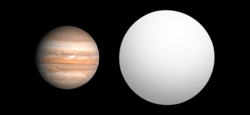Astronomy:CoRoT-1b
 Size comparison of CoRoT-1b with Jupiter. | |
| Discovery | |
|---|---|
| Discovered by | Barge et al. |
| Discovery site | France |
| Discovery date | 3 May 2007[3] |
| Transit | |
| Orbital characteristics | |
| 0.02752+0.00022 −0.00023 AU | |
| Eccentricity | <0.036[4] |
| Orbital period | 1.5089682±0.0000005[5] d |
| Inclination | 85.10±0.50[6] |
| Star | CoRoT-1[2] |
| Physical characteristics | |
| Mean radius | 1.715±0.030[4] |♃|J}}}}}} |
| Mass | 1.23±0.10[4] |♃|J}}}}}} |
| Mean density | 380 ± 50 kg/m3 (641 ± 84 lb/cu yd)[6] |
| 11.5 m/s2 (38 ft/s2)[7] | |
| Physics | 1,898±50[6] |
CoRoT-1b[2] (previously named CoRoT-Exo-1b)[1] is a transiting extrasolar planet approximately 2,630 light-years away in the constellation of Monoceros. The planet was discovered orbiting the yellow dwarf star CoRoT-1 in May 2007. The planet was the first discovery by the French-led CoRoT Mission.
Discovery
CoRoT-1b was identified as the best planetary candidate from the CoRoT spacecraft initial run from February 6 to April 2, 2007. Follow-up photometry with the Wise Observatorys 1.0 m telescope and at the Canada–France–Hawaii Telescope eliminated many of the possible false positives for the transit signal. 9 radial velocity measurements of CoRoT-1 were made at Haute-Provence Observatory in March–April and October 2007 with the SOPHIE échelle spectrograph. The radial velocity data matched the CoRoT light curve and supported the planetary nature of CoRoT-1b and eliminated other possibilities such as background stars, grazing eclipsing binaries, or a triple system.[6]
The discovery was publicly announced on May 3, 2007[3] and submitted for publication on January 4, 2008.[6]
Characteristics
The planet is a large hot Jupiter, about 1.49 times the radius of Jupiter and approximately 1.03 times as massive, based on ground observations of the star. Its large size is due to its low density combined with the intense heating of its parent star causing the outer layers of the atmosphere to bloat.[6]
Observation of phases
In May 2009 CoRoT-1b became the first extrasolar planet for which optical (as opposed to infrared) observations of phases were reported.[8] These observations suggest that there is not significant heat transfer between the (tidally locked) night and day sides of the planet.[9]
See also
- 51 Pegasi b
- CoRoT-2b
- TrES-1
References
- ↑ 1.0 1.1 Schneider, J. (2009-03-10). "Change in CoRoT planets names". Exoplanets (Mailing list). Archived from the original on 2010-01-18. Retrieved 2009-03-19.
- ↑ 2.0 2.1 2.2 "Notes for planet CoRoT-1 b". Extrasolar Planets Encyclopaedia. https://exoplanet.eu/catalog/corot_1_b--401/.
- ↑ 3.0 3.1 "COROT discovers its first exoplanet!". 2007-05-03. https://cnes.fr/en/web/CNES-en/5918-corot-discovers-its-first-exoplanet.php.
- ↑ 4.0 4.1 4.2 Bonomo, A. S. et al. (2017). "The GAPS Programme with HARPS-N at TNG . XIV. Investigating giant planet migration history via improved eccentricity and mass determination for 231 transiting planets". Astronomy and Astrophysics 602: A107. doi:10.1051/0004-6361/201629882. Bibcode: 2017A&A...602A.107B. https://www.aanda.org/articles/aa/full_html/2017/06/aa29882-16/aa29882-16.html.
- ↑ Sada, Pedro V. et al. (2012). "Extrasolar Planet Transits Observed at Kitt Peak National Observatory". Publications of the Astronomical Society of the Pacific 124 (913): 212–229. doi:10.1086/665043. Bibcode: 2012PASP..124..212S.
- ↑ 6.0 6.1 6.2 6.3 6.4 6.5 Barge, P. et al. (2008). "Transiting exoplanets from the CoRoT space mission I. CoRoT-Exo-1b: a low-density short-period planet around a G0V star". Astronomy and Astrophysics 482 (3): L17–L20. doi:10.1051/0004-6361:200809353. Bibcode: 2008A&A...482L..17B.
- ↑ Calculated using Newtonian gravity:
- ↑ Ignas A. G. Snellen; Ernst J. W. de Mooij; Simon Albrecht (2009-05-28). "The changing phases of extrasolar planet CoRoT-1b". Nature 459 (7246): 543–545. doi:10.1038/nature08045. PMID 19478779. Bibcode: 2009Natur.459..543S.
- ↑ Andrea Thompson (2009-05-27). Exoplanet Phases Seen in Optical Light. http://www.space.com/scienceastronomy/090527-exoplanet-phases.html. Retrieved 2009-05-27.
External links
- "COROT discovers its first exoplanet and catches scientists by surprise". European Space Agency. 2007-05-03. http://www.esa.int/esaCP/SEMCKNU681F_index_0.html.
- Morelle, Rebecca (2007-05-03). "Space telescope spots new planet". BBC News. http://news.bbc.co.uk/2/hi/science/nature/6611557.stm.
Coordinates: ![]() 06h 48m 19.17s, −03° 06′ 07.78″
06h 48m 19.17s, −03° 06′ 07.78″
 |

